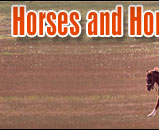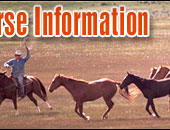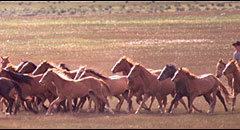 |
   |
|
|
|
You are here: Horses > Horse breeds >
Miniature Horses |
Miniature Horse Breed Makes a Great Household Pet
Originally bred as pets for the children of royalty in the 1600ís, the
miniature horse breed also spent time working in the mines and now
mainly appear in their own shows. They are considered gentle animals
that are affectionate and genuinely eager to please still making them
perfect pets. |
|
|
In addition to their role as pets, they were also kept as curiosities
and appeared in circuses where their reputation as performers grew. It
was not until the late 18th century that they because used as pit
ponies, working the mines in Wales and in Great Britain. In the 1800ís,
because of their size, they were imported to the United States to work
in the coal mines of Appalachia. American breeders took an interest in
the miniature horse breed and began selective breeding practices to
breed a miniature with perfect proportions to the larger animals. |
The American Miniature Horse Association, founded in
1978, lists two classes of miniatures, class A being
34 inches tall or less, and class B ranging from 34
to 38 inches tall. In order to appear in horse shows
as a miniature, the animal can be no taller than 34
inches, which is eight and half hands. Today, the
AMHA registers about 140,000 animals around the
world. Their breeding goal is to develop the
smallest possible horse that maintains the correct
conformity and the smallest of the breed is
considered more desirable.
 They are found in a variety of colors including bay,
black, buckskin, chestnut, grey, palomino, pinto and
white. They should have a head in proportion to the
body and neck with a broad forehead and eyes widely
spaced. Medium sized ears should be pointed with a
long, flexible neck. Hooves should be rounded with
legs straight and parallel to each other and the
animalís croup should be the same height as the
withers. They are found in a variety of colors including bay,
black, buckskin, chestnut, grey, palomino, pinto and
white. They should have a head in proportion to the
body and neck with a broad forehead and eyes widely
spaced. Medium sized ears should be pointed with a
long, flexible neck. Hooves should be rounded with
legs straight and parallel to each other and the
animalís croup should be the same height as the
withers.
Many times the miniature horse breed is confused
with dwarf horses and although dwarfs may be cute,
they are not considered as miniatures due to
irregularities in conformity. Their strength is also
in proportion to their build and are capable of
pulling loads that are also in proportion and as
such are still used as circus attractions, often
dressed in colorful costumes and pulling miniature
carts.
Because of their gentle nature, many still own
miniature horses as pets as they thrive on attention
with a great display of curiosity and intelligence.
While many people have always wanted to own a horse,
but had reservations of owning, handling and caring
for an animal that could weight over 1,000 pounds,
are finding the miniature horse breed ideal. About
an acre of land is usually sufficient roaming
territory for exercise and outdoor feeding and
caring for a miniature is the same as for any other
horse breeds, only on a much smaller scale.
They are also used in therapeutic value is also
growing for use with disabled children and adults
and they are used for people of all walks of life in
stressful jobs or situations.
The lifespan of a miniature horse is about 30 years,
although on miniature in North Carolinaís protective
area attained the age of 50.

|
Read the next horse breeds article on
pinto horses. |
|
|
|
|
 |
|
|
 |
 |
  
Visit Equestrian Cupid now.
The best and largest equestrian club for meeting the other half for friendship and marriage
|
|
 |
|
|
|
Horse Education
|
|
|
|
|
Horse Information Topics
|
|
|
|
|
|
|
|
Horse Business Owners
|
| |
Advertise with Us
Have your horse products or services exposed to over 27,000 of our monthly visitors.
|
|
|
|
|
|